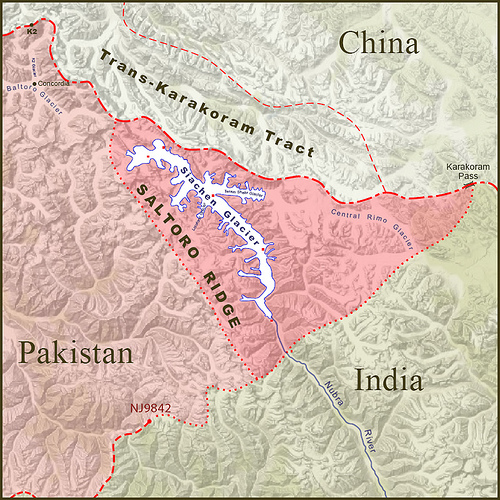GIANT CRACKS IN SIACHEN: A SERIOUS THREAT TO CLIMATE
Arshad H. Abbasi
New satellite images show growing giant cracks forming through the Siachen Glacier, the second longest glacier on the planet. One of the most serious observations is the formation of a stream.
Development of cracks, streams, and glacial lakes show that glacier may disappear, if immediate measures are not taken by Pakistan and India.
The cause of these cracks is not global warming; rather it is the presence of the Indian army on the Siachen Glacier since 1984. The glacier is melting at an unprecedented rate and this has already been reported. The melting has been attributed to the deployment of troops and establishment of permanent cantonments. However, decision makers of both countries have turned a deaf ear to this climatic disaster. The Indian government is trying its best to associate the cause of glacier melting to the phenomenon of global warming, which is undoubtedly baseless and merely a case of evasion of responsibility.
Glaciers melt into glacial lakes, leading to the formation of a stream which later joins the Nubra River. This has been due to attempts by Indian army to facilitate movement of its troops. Indian army is responsible for the cutting and melting of glacial ice through application of chemicals for construction of bunkers.
SDPI is constantly highlighting this damage that would cause the Siachen glacier and its environment through dumping of chemicals, metals, organic and human waste, and daily leakages from 2000 gallons of kerosene oil. The oil would pass through 250 km of a plastic pipeline, laid by the Indian
army throughout the glacier.
Here it is worth mentioning that this scribe has categorically been denying throughout, all claims by Indian meteorologists that Siachen and other glaciers in Jammu and Kashmir are melting due to the global warming rather than direct human activity. It has been a challenge for scientists working on climate change to understand how the adjoining Baltoro glacier on the other side of Saltoro Ridge which divides the two glaciers, does not seem to be experiencing the same effect.
The causes of recent floods in Pakistan are blamed on El Niño but very less attention is being paid to the cloud burst in Siachen and Ladakh Region, which is because of an uneven development including development of airports and helipads on various locations of glaciers. The unprecedented cloud burst broke all records of rainfall of modern recorded history of meteorological data pertaining to the region. Since last couple of years it was emphasized and urged from the Indian government to save and preserve these glaciers, as these are declared climate change indicators.
Although the scientists agreed that recent territorial monsoon rainfall has been because of the confluence of the Western Monsoon system, they failed to correlate on the reasons behind this atmospheric weather divide. It has been reported in various international research institution that rainfalls caused the 2010 floods in Pakistan. The Ministry of Foreign Affairs never raised the question of melting glaciers, which ultimately appeared disastrous for Pakistan.
In 2005, a team from the University of Newcastle, UK established this after finding out from compilation of temperature data for several instrumental records. The Karakoram and Hindu Kush Mountains of the Upper Indus Basin (UIB) had been analyzed for seasonal and annual trends over the period 1961-2000 and compared with neighboring mountain regions of Pakistan and India. Strong contrasts are found between the behavior of winter and summer temperatures and between maximum and minimum temperatures but decision makers of both countries remained unmoved. This is of particular concern on part of the Ministry of Environment and Ministry of Water and Power, which never took this issue to an international level.
Pakistan Government needs to take the case to the International Court of Justice, as the issue remains to be one of the most potent cases of climate change injustice caused to a neighboring country. An international commission should be established based on neutral climate change experts to fix the responsibility and quantify the impacts. Based on the findings, Pakistan should pursue international community to pressure India for an immediate demilitarization of Siachen and declaration of all glaciers as protected areas.
These glaciers could be handed over to UNESCO or concerned parties to avoid any future calamity. Furthermore, Pakistan should claim financial losses made due to the floods.
SDPI is an independent Pakistani think-tank based in Islamabad.
Disclaimer: The views expressed in this article are the sole responsibility of the author and do not necessarily reflect those of the ‘Wonders of Pakistan’. The contents of this article too are the sole responsibility of the author(s). WoP will not be responsible or liable for any inaccurate or incorrect statements contained in this post.
YOUR COMMENT IS IMPORTANT
DO NOT UNDERESTIMATE THE POWER OF YOUR COMMENT


No comments:
Post a Comment